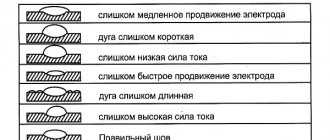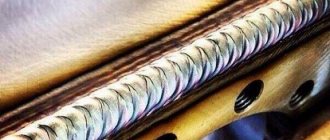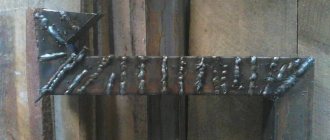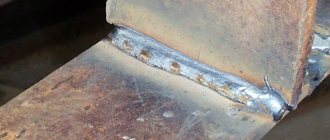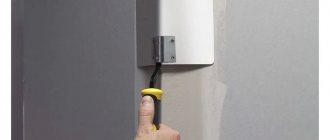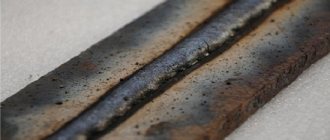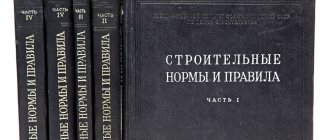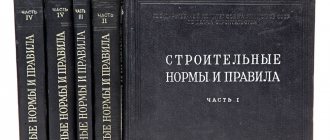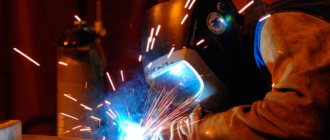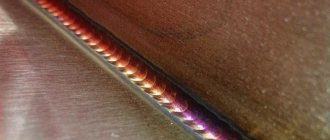Nowadays, welding is needed to connect parts made of different materials, such as metal. There are many varieties of this process because welding is used for many purposes: from household needs to the creation of more complex structures.
The technology itself is not very complicated, if you understand the theory well (types of welding, technologies, basic concepts), then all that remains is to practice creating seams so that they are of high quality, and therefore not only beautiful, but also durable.
So anyone can do this, the main thing is to devote time to self-education.
Electrode tilt
Welding seams are classified according to several criteria. The types and types of welding joints must be considered sequentially, delving into the intricacies of the process. The seam is affected by the location, direction and trajectory of the electrode.
After fixing the selected electrode in the clamp, setting the current, connecting the polarity, the welding process begins.
Each master has his own preferred angle of the electrode. Many consider the optimal value to be 70° from the horizontal surface.
An angle of 20° is formed from the vertical axis. Some work at a maximum angle of 60°. In general, most training guidelines include a range of 30° to 60° from the vertical axis.
In certain situations, when welding in hard-to-reach places, it is necessary to orient the electrode strictly perpendicular to the surface of the material being welded.
You can also move the electrode in different ways, in opposite directions: away from you or towards you.
If the material requires deep heating, then the electrode is directed towards itself. Following him in the direction of the welder is the working area. The resulting slag covers the fusion site.
If the work does not involve strong heating, then the electrode is moved away from you. The welding zone “crawls” behind it. The depth of heating with this type of weld is minimal. The direction is clear.
Types and techniques of welding seams
Today, the most popular type of joining parts into a monolithic product is welding. There are many types of it, since welding work is used in many industries, from households to the creation of complex technical structures. It’s not difficult to learn the art of welding, the main thing is to understand the basic concepts, distinguish between types of welding and get good at guiding the electrode (torch) to create a beautiful, durable and high-quality seam.
Welding principles and basic concepts
Before we move on to the technology of how to properly lay a welding seam, let’s look at a few concepts:
- a welded connection is the joining of two parts using a welding method;
- welding seam is a section of a welded joint, which was formed due to the molecular connection of the molten edges of two metal parts, as a result of further crystallization of the metal;
- weld metal is an alloy that is formed as a result of thermal effects on the base metal (part);
- the fusion zone is the boundary between the weld metal and the base metal (product);
- a thermally affected zone is an area that was exposed to heat, but did not melt, but only changed its properties due to heating.
- welding is a process during which metal is melted using special equipment that connects elements by melting their edges;
- electric arc is a discharge that occurs between the workpiece and the electrode;
- An electrode is a special metal rod with various chemical coatings that conducts electric current.
Different industries use different types of welding, which differ in the method of influence, the use of different materials and operating technologies to create simple and multi-pass seams. For example, in arc welding, the main melting element is the electrode, which excites and holds the arc on the workpiece. In gas welding, the heat source is a torch, from which, under strong pressure, an even, uninterrupted flame emerges, formed as a result of the combustion of a mixture of oxygen and acetylene.
Although different types of welding have different effects on the part, the essence remains the same: two metal products are placed tightly against each other or with a short distance if, for example, it is necessary to weld a leaky part. Next, using a welding machine, the master heats the edges of the part so that they begin to melt. At this moment, a so-called weld pool is formed. In addition to the base metal, an additional one (electrode or wire) is often used to increase the amount of weld metal. When the molten material is ready, a path is formed. It then crystallizes and forms a strong compound.
Types of seams and technology
When the master has already mastered how to properly weld, you can proceed directly to the types and techniques of the seam. The key to a quality connection is the correct settings on the welding machine (transformer or inverter), in accordance with the characteristics of the metal and its melting point. Soft metals are cooked at low currents, dense metals at high currents. It is also necessary to take into account the type of weld, since each of them has its own technique. The most common types of seams:
1. In appearance – flat, reinforced and weakened.
2.According to the technique of execution - single-sided and double-sided (in which the master solders the workpieces on both sides).
3.By the number of layers - one-, two-, three-layer.
4. By length - point, double-sided chess, chain, point, continuous.
5.In the direction of force - transverse, longitudinal, oblique, combined.
6. According to spatial placement - horizontal, vertical, ceiling, bottom.
Let's now move on to the technology of making the seam. Let's consider the main stages of work:
1. Preparatory. This step requires some preparatory work to be done. First, prepare the workplace in accordance with safety rules. Secondly, stock up on overalls and a protective mask to prevent eye burns. Third, prepare the product for use. To do this, it must be cleaned of any remaining paint, varnish, oil, dust and other contaminants. To do this, use a metal brush or highly abrasive sandpaper. Then you need to set all the settings on the welding machine and you can start.
2.Creating an arc or igniting the torch (depending on the type of welding). Features of electric arc welding can be read here, and gas welding here.
3. At this stage, welding seams are created (consider electrode guiding techniques in more detail).
4.Final stage. When the track is ready, you must remember to knock off the slag from the roller (for arc welding). Connections created by gas and plasma welding do not slag, that is, there is no debris from them.
Electrode guiding technique is the key to a beautiful welding seam
To create a perfect seam, it is not enough to move the electrode in a straight line along the gap between the parts. There are several methods for creating connections. All of them are based on the smooth movement of the electrode along a certain path, resulting in a smooth path.
To create a beautiful welding seam, the torch or electrode needs to be slightly rotated in relation to the part by 60 degrees. It needs to be done smoothly, but it is important not to hold the conductor in one place so as not to scorch the workpiece. The easiest way is “zigzag”. In this case, the conductor is drawn from the right fusion zone to the left one slightly diagonally. You should return in a mirror image and the result will be as if the master is conventionally drawing a zigzag. This connection can be used for different types of alloys and metals.
If the gap between the workpieces is more than 5 millimeters, then it is better to use the herringbone technique. In this case, more movements are made, which allow you to fuse more material for bonding. It is recommended to start on the right side and lead the conductor with an even horizontal line to the left, then at an angle of 45 degrees you need to return down to the middle of the seam and at the same angle lay a line upward, stretching it above the one from which you started. Thus, you will get a conditional Christmas tree created from many triangles. In this case, the main thing is not to increase the distance between the electrode and the workpiece, so as not to lose the arc (during electric arc welding).
Beautiful connections are obtained using the “loop” technique. It can be used for thin metal when working semi-automatically or gas welding. Here the seams should be applied in smooth, rounded movements, reminiscent of a continuous chain of loops.
In the picture you can see what other methods are used to apply welds.
Tips from the professionals
Masters who easily create tracks of any complexity and in any position share some tips with novice welders who do not understand why they cannot make this or that connection:
- it is important to maintain the same width of the gap along the entire seam, then it will be of high quality and reliable;
- the distance between the part and the electrode must not be violated, since when the arc is lost, the connection is deformed;
- the electrode or burner must be held at an angle of 60-75 degrees relative to the seam, thus the metal quickly crystallizes without drips;
- when working on a vertical surface, it is better to weld from the bottom up, this way you will avoid the spreading of the metal formed during welding.
In conclusion, it should be noted that we looked at the basic techniques for making a good seam. You can find out more in the following video:
svarkaed.ru
Trajectory of movement
The trajectory of the electrode has a particular influence on the seam. In any case, it has an oscillatory character. Otherwise, it will not be possible to sew the two surfaces together.
Oscillations can be similar to zigzags with different steps between the sharp corners of the trajectory. They can be smooth, resembling movement in an offset figure eight. The path can be similar to a herringbone or a capital letter Z with monograms at the top and bottom.
An ideal seam has a constant height, width, uniform appearance without defects in the form of craters, undercuts, pores, or lack of penetration. The name of the possible flaws speaks for itself. Having mastered your skills well, you can successfully apply any seam and weld a variety of metal parts.
Ignition of an arc with an electrode
In order to light an arc, you need to bring the electrode to the metal and lightly tap it on the surface, immediately moving it upward. There is no need to move the electrode too far, since the arc will certainly go out. It is enough to withdraw by 2-3 mm.
You can also light an electrode by striking its end against a metal surface. We just take it and, as it were, move the electrode with a short movement across the metal until the welding arc lights up.
Standards and the concept of leg
The weld begins to form in the working area when the metals are molten, and is finally formed after solidification.
The existing classification groups seams according to various criteria: the type of connection of parts, the resulting shape of the seam, its length, the number of layers, orientation in space.
The types of possible welded joints are shown in the standard for manual and arc welding GOST 5264. Connections made by arc welding in a shielding gas atmosphere are standardized by the GOST 14771 document.
GOSTs have a designation for each welded joint, as well as a table containing the main characteristics, in particular the values of the leg of the weld.
It’s quite easy to understand what a leg is by looking at the drawing of the parts being connected. This is the side of a speculative isosceles triangle of maximum dimensions that will fit in the cross section of the seam. A correctly calculated leg value guarantees the strength of the connection.
For parts of uneven thickness, the cross-sectional area of the part in its thinnest part is taken as a basis. You should not try to unduly increase the leg. This can lead to deformation of the welded structure. In addition, the consumption of materials will increase.
Checking leg dimensions is carried out using universal reference templates presented in specialized literature.
Types and methods of making welding seams
The ultimate goal of any welder is to obtain a high-quality weld. The strength and durability of the connection of parts depends on this. For successful operation, it is important to make the connection correctly; select the current strength, the angle of the electrode; have a good command of the seam technique. The result of proper work will be reliable welding of metal parts.
Electrode tilt
Welding seams are classified according to several criteria. The types and types of welding joints must be considered sequentially, delving into the intricacies of the process. The seam is affected by the location, direction and trajectory of the electrode.
After fixing the selected electrode in the clamp, setting the current, connecting the polarity, the welding process begins.
Each master has his own preferred angle of the electrode. Many consider the optimal value to be 70° from the horizontal surface. An angle of 20° is formed from the vertical axis. Some work at a maximum angle of 60°. In general, most training guidelines include a range of 30° to 60° from the vertical axis. In certain situations, when welding in hard-to-reach places, it is necessary to orient the electrode strictly perpendicular to the surface of the material being welded.
You can also move the electrode in different ways, in opposite directions: away from you or towards you.
If the material requires deep heating, then the electrode is directed towards itself. Following him in the direction of the welder is the working area. The resulting slag covers the fusion site.
If the work does not involve strong heating, then the electrode is moved away from you. The welding zone “crawls” behind it. The depth of heating with this type of weld is minimal. The direction is clear.
Trajectory of movement
The trajectory of the electrode has a particular influence on the seam. In any case, it has an oscillatory character. Otherwise, it will not be possible to sew the two surfaces together. Oscillations can be similar to zigzags with different steps between the sharp corners of the trajectory. They can be smooth, resembling movement in an offset figure eight. The path can be similar to a herringbone or a capital letter Z with monograms at the top and bottom.
An ideal seam has a constant height, width, uniform appearance without defects in the form of craters, undercuts, pores, or lack of penetration. The name of the possible flaws speaks for itself. Having mastered your skills well, you can successfully apply any seam and weld a variety of metal parts.
Standards and the concept of leg
The weld begins to form in the working area when the metals are molten, and is finally formed after solidification. The existing classification groups seams according to various criteria: the type of connection of parts, the resulting shape of the seam, its length, the number of layers, orientation in space.
The types of possible welded joints are shown in the standard for manual and arc welding GOST 5264. Connections made by arc welding in a shielding gas atmosphere are standardized by the GOST 14771 document.
GOSTs have a designation for each welded joint, as well as a table containing the main characteristics, in particular the values of the leg of the weld.
It’s quite easy to understand what a leg is by looking at the drawing of the parts being connected. This is the side of a speculative isosceles triangle of maximum dimensions that will fit in the cross section of the seam. A correctly calculated leg value guarantees the strength of the connection.
For parts of uneven thickness, the cross-sectional area of the part in its thinnest part is taken as a basis. You should not try to unduly increase the leg. This can lead to deformation of the welded structure. In addition, the consumption of materials will increase. Checking leg dimensions is carried out using universal reference templates presented in specialized literature.
Types of connections
Depending on the relative position of the parts, welding joints occur:
- end-to-end;
- overlap;
- in an angular way;
- in a tee way.
When butt welding, the ends of two parts located in the same plane are welded. The joint can be made with a flange, without a bevel, or with a bevel. The shape of the bevel may resemble the letters X, K, V.
In some cases, welding is done with an overlap, then one part is partially mounted on another, located parallel. The combined part is an overlap. Welding is done without bevel on both sides.
Often there is a need to make a welded corner. This connection is referred to as the corner type. It is always done on both sides and may not have bevels or have a bevel on one edge.
If the welded parts result in the letter T, then a T-joint has been made. Sometimes parts welded with a T-seam form an acute angle. In any case, one part is welded to the side of the other. Welding is carried out on both sides without a bevel or with bevels on each side.
Shape and extent
The shape of the seam can be convex, even (flat). Sometimes it becomes necessary to make a concave shape. Convex joints are designed for increased load. The concave areas of the alloys withstand dynamic loads well. Flat seams, which are made most often, are characterized by versatility.
The length of the seams is continuous, without intervals between the fused joints. Sometimes interrupted stitches are sufficient.
An interesting industrial variation of the intermittent seam is the joint formed by resistance seam welding. It is done on special equipment equipped with rotating disk electrodes. They are often called rollers, and this type of welding is called roller welding. Continuous connections can also be made using such equipment. The resulting seam is very strong and absolutely airtight. The method is used on an industrial scale for the manufacture of pipes, containers, and sealed modules.
Layers and spatial arrangement
A metal seam can consist of a bead made in one pass. In this case it is called single-layer. If the parts being welded are thick, several passes are performed, as a result of which beads are sequentially formed one on top of the other. This welding joint is called multilayer.
Considering the variety of production situations in which welding occurs, it is clear that the seams are oriented differently in each specific case. There are lower, upper (ceiling) seams, vertical and horizontal.
Vertical seams are usually welded from bottom to top. The trajectory of moving the electrode along a crescent, herringbone or zigzag is used. It is more convenient for novice welders to move the crescent.
When welding horizontally, several passes are made from the lower edge of the parts being joined to the upper edge.
In the lower position, butt welding is carried out or by any angular method. A good result is obtained by welding at an angle of 45 °, “in a boat”, which can be symmetrical or asymmetrical. When welding in hard-to-reach places, it is better to use an asymmetrical “boat”.
The most difficult thing to do is weld in the ceiling position. This requires experience. The problem is that the melt tries to drain out of the work area. To prevent this from happening, welding is carried out with a short arc, the current strength is reduced by 15-20% compared to normal values. If the thickness of the metal at the welding site exceeds 8 mm, then several passes must be performed. The diameter of the first pass should be 4 mm, subsequent ones - 5 mm.
Depending on the orientation of the seam, the appropriate position of the electrode is selected. To make horizontal, vertical, ceiling connections, and weld non-rotating pipe joints, the electrode is directed at an angle forward. When welding corner and butt joints, the electrode is directed at an angle backwards. Hard-to-reach places are welded with an electrode at a right angle.
Weld joint processing
When welding, slag is formed. If slag inclusions get into the weld, its quality deteriorates. All slag deposits must be cleaned off.
If welding is performed in several passes, then the seams are cleaned after each welding stage. In this case, any methods are used. First, the welded parts are hammered and cleaned with a stiff brush. Then a rough cleaning is carried out. Small parts are cleaned with special knives or grinding wheels. Large blanks are cleaned on machines. At the final stage, the welded joint is polished. Often a fiber wheel of a grinding machine is used for this. There are other ways to polish welded joints.
Welding is constantly evolving. New materials are appearing and technology is improving. It is necessary to follow the news in welding to learn a lot of new and interesting things.
Similar articles
svaring.com
Types of connections
Depending on the relative position of the parts, welding joints occur:
- end-to-end;
- overlap;
- in an angular way;
- in a tee way.
When butt welding, the ends of two parts located in the same plane are welded. The joint can be made with a flange, without a bevel, or with a bevel. The shape of the bevel may resemble the letters X, K, V.
In some cases, welding is done with an overlap, then one part is partially mounted on another, located parallel. The combined part is an overlap. Welding is done without bevel on both sides.
Often there is a need to make a welded corner. This connection is referred to as the corner type. It is always done on both sides and may not have bevels or have a bevel on one edge.
If the welded parts result in the letter T, then a T-joint has been made. Sometimes parts welded with a T-seam form an acute angle.
In any case, one part is welded to the side of the other. Welding is carried out on both sides without a bevel or with bevels on each side.
Shape and extent
The shape of the seam can be convex, even (flat). Sometimes it becomes necessary to make a concave shape. Convex joints are designed for increased load.
The concave areas of the alloys withstand dynamic loads well. Flat seams, which are made most often, are characterized by versatility.
The length of the seams is continuous, without intervals between the fused joints. Sometimes interrupted stitches are sufficient.
An interesting industrial variation of the intermittent seam is the joint formed by resistance seam welding. It is done on special equipment equipped with rotating disk electrodes.
They are often called rollers, and this type of welding is called roller welding. Continuous connections can also be made using such equipment. The resulting seam is very strong and absolutely airtight. The method is used on an industrial scale for the manufacture of pipes, containers, and sealed modules.
Layers and spatial arrangement
A metal seam can consist of a bead made in one pass. In this case it is called single-layer. If the parts being welded are thick, several passes are performed, as a result of which beads are sequentially formed one on top of the other. This welding joint is called multilayer.
Considering the variety of production situations in which welding occurs, it is clear that the seams are oriented differently in each specific case. There are lower, upper (ceiling) seams, vertical and horizontal.
Vertical seams are usually welded from bottom to top. The trajectory of moving the electrode along a crescent, herringbone or zigzag is used. It is more convenient for novice welders to move the crescent.
When welding horizontally, several passes are made from the lower edge of the parts being joined to the upper edge.
In the lower position, butt welding is carried out or by any angular method. A good result is obtained by welding at an angle of 45 °, “in a boat”, which can be symmetrical or asymmetrical. When welding in hard-to-reach places, it is better to use an asymmetrical “boat”.
The most difficult thing to do is weld in the ceiling position. This requires experience. The problem is that the melt tries to drain out of the work area. To prevent this from happening, welding is carried out with a short arc, the current strength is reduced by 15-20% compared to normal values.
If the thickness of the metal at the welding site exceeds 8 mm, then several passes must be performed. The diameter of the first pass should be 4 mm, subsequent ones - 5 mm.
Depending on the orientation of the seam, select the appropriate position of the electrode . To make horizontal, vertical, ceiling connections, and weld non-rotating pipe joints, the electrode is directed at an angle forward.
When welding corner and butt joints, the electrode is directed at an angle backwards. Hard-to-reach places are welded with an electrode at a right angle.
The ideal welding seam - what is it?
If you need to get a beautiful and high-quality seam, buy modern electrodes. Yes, yes, leave the “old-fashioned” wire, on which there is almost no coating left. Use new and dry electrodes according to the manufacturer's instructions. Find on the package with electrodes the current at which you need to cook, as well as the polarity, that is, + and - connections.
If reverse polarity is indicated on the electrodes, then connect the plus from the inverter to the electrode holder. If you need to weld with direct polarity, then the plus should go as a mass, that is, connect to the metal being welded.
So, we connect the cables to the inverter and insert the electrode into the electrode holder. We set the required welding current on the inverter and turn on the machine. The electrode must be held in the holder strictly at an angle of 90 degrees and nothing else.
Weld joint processing
When welding, slag is formed. If slag inclusions get into the weld, its quality deteriorates. All slag deposits must be cleaned off.
If welding is performed in several passes, then the seams are cleaned after each welding stage. In this case, any methods are used. First, the welded parts are hammered and cleaned with a stiff brush.
Then a rough cleaning is carried out. Small parts are cleaned with special knives or grinding wheels. Large blanks are cleaned on machines. At the final stage, the welded joint is polished.
Often a fiber wheel of a grinding machine is used for this. There are other ways to polish welded joints.
Welding is constantly evolving. New materials are appearing and technology is improving. It is necessary to follow the news in welding to learn a lot of new and interesting things.
